Zhongnanhai
Zhongnanhai (Chinese: 中南海; pinyin: Zhōngnánhǎi; lit.: 'Central and Southern Seas') is a former imperial garden in the Imperial City, Beijing, adjacent to the Forbidden City; it serves as the central headquarters for the Communist Party of China and the State Council (Central government) of China. Zhongnanhai houses the office of the General Secretary of the Communist Party of China (paramount leader) and Premier of the People's Republic of China. The term Zhongnanhai is closely linked with the central government and senior Communist Party officials. It is often used as a metonym for the Chinese leadership at large (in the same sense that the term "White House" refers to the U.S. executive branch).
| Zhongnanhai 中南海 | |
|---|---|
Xinhuamen, the "Gate of New China" built by Yuan Shikai, today the formal entrance to the Zhongnanhai compound | |
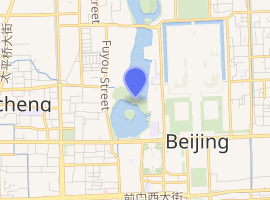
| |
| General information | |
| Architectural style | Traditional Chinese Architecture |
| Address | 174 Chang'an Avenue, Xicheng District, Beijing[1] |
| Coordinates | 39°54′41″N 116°22′50″E |
| Current tenants |
|
| Zhongnanhai | |||||||
|---|---|---|---|---|---|---|---|
| Traditional Chinese | 中南海 | ||||||
| Simplified Chinese | 中南海 | ||||||
| Literal meaning | Central and Southern Seas | ||||||
| |||||||
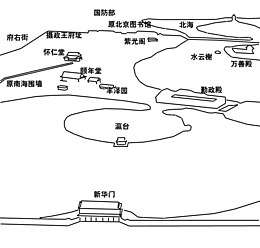
The state leaders, including Xi Jinping, current General Secretary of the Communist Party, and other top CPC and PRC leadership figures carry out many of their day-to-day administrative activities inside the compound, such as meetings with foreign dignitaries. China Central Television frequently shows footage of meetings inside the compound, but limits its coverage largely to views of the interior of buildings. Though numerous maps of the complex exist from before the founding of the People's Republic of China, the interior layout of Zhongnanhai has been altered significantly since then, including a wave of major renovations in 1970s. Today many buildings share the names of older, pre-PRC structures, but have completely changed in layout and purpose. The north section of Zhongnanhai is used as the headquarters of the State Council and includes the offices of its senior most leaders. South Zhongnanhai is the headquarters of the Central Committee and its highest level coordinating institutions, such as the Standing Committee, Politburo and Secretariat.
The current basic outline of Zhongnanhai emerged during the Ming dynasty when the southernmost of the two lakes in the complex was created in 1421. By the late Qing Dynasty, Zhongnanhai was used as the de-facto center of the government, with Empress Dowager Cixi and later Prince Regent Chun building residences there instead of the Forbidden City. After the establishment of the Republic of China, the new president, Yuan Shikai remodeled Zhongnanhai to become the formal center of what would become known as the Beiyang Government. In 1949, Chairman Mao Zedong moved into the complex after the establishment of the People's Republic of China. Mao received many important foreign leaders in Zhongnanhai, including Nikita Khrushchev, Che Guevara, Richard Nixon, Georges Pompidou, Kakuei Tanaka and Zulfikar Ali Bhutto, among others.[2][3] Mao's favorite places in Zhongnanhai were the Library of Chrysanthemum Fragrance (his personal residence, filled with bookshelves) and the Poolside House, next to the large indoor swimming pool, where he would spend much of the day swimming or reading books and reports by the pool. After Mao's death, the Chrysanthemum Library along with many of his belongings was preserved as a museum which is not accessible to the general public.[4]
Location

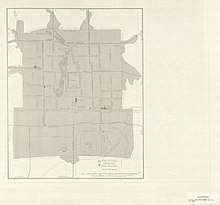
The name of the Zhongnanhai complex, located west of the Forbidden City, means "central and southern seas/lakes", referring to two lakes (the "Central Sea" (中海) and "Southern Sea" (南海)) located within the compound; it is sometimes translated as "Sea Palaces". These two lakes are part of a series of projects carried out during the construction of the nearby Forbidden City. Also part of the same system is the "Northern Sea", or "Beihai" (北海), now a public park. The Northern, Central and Southern Seas are called Taiye Lake (太液池) together. And the "Shichahai" (什剎海) is connected to Beihai at the north.
The Taiye Lake were originally an imperial garden called Xiyuan (Western Park, 西苑) or Xinei (Western Court, 西內), with parklands on the shores, enclosed by a red wall in the west part of the Imperial City, Beijing. Most of the pavilions, shrines, and temples survive from this period. Whereas the Northern sea had a religious focus, the shores of Central and Southern seas were dotted with a number of palaces.[5]
History

During the Jin dynasty (1115–1235), the Emperor Zhangzong of Jin built the northern lake in 1189. The northern section of Zhongnanhai was the Taiye Lake, with an attached palace called the "Palace of Great Peace" (Daninggong). During the Yuan Dynasty, which lasted from 1271 to 1368, Taiye Lake was included within the Imperial City. It was also expanded, covering approximately the area occupied by the Northern and Central Seas today. Three palaces were built around the lake.
After the Ming dynasty moved its capital to Beijing in 1403 by order of the Yongle Emperor, construction on the existing Imperial Palace began in 1406. The Ming palace was to the south of the Yuan dynastic palace. As a result, a new Southern Sea was dug to the south of the old lake. The excavated soil, together with that from construction of the moat, was piled up to form Jingshan, a hill to the north of the Forbidden City. At this time, the three lakes were connected and were collectively called the Taiye Lake.[1] The three lakes were divided by bridges. The lakes were part of an extensive royal park called Xiyuan (Western Garden) to the west of the Imperial Palace.
After the Qing dynasty established its capital in Beijing, the government reduced the size of the royal park to within a small walled area around the three lakes. Several successive emperors built pavilions and houses along the lake shores, where they would carry out government duties in the summer. During the reign of the Empress Dowager Cixi, the Empress Dowager and the Emperor would often live in the Zhongnanhai compound, travelling to the Forbidden City only for ceremonial duties.
During the Boxer Rebellion of 1899 - 1901, the Russian army occupied Zhongnanhai. Almost all artifacts and decorations in the compound were looted. Later, the Eight-Nation Alliance commander also lived in Zhongnanhai. When Puyi was crowned Emperor, his father as the Prince Regent lived for a short time in the compound.[6]
Zhongnanhai continued to be politically significant during the Republic of China era, when the Beiyang Government under Yuan Shikai, placed its presidential palace in the Zhongnanhai compound from 1911.[7] This decision was made because the regime wished to house its government very close to the historical centre of power, the Forbidden City, but could not use the Forbidden City itself because the abdicated Emperor Puyi still lived there. The current main gate, Xinhua Gate or "Gate of New China", was created by Yuan Shikai. The present "gatehouse" was previously a pavilion located on the southern shore the Southern Sea, close to the southern wall. Entry to the compound was instead directly from the Forbidden City. Yuan wished to create a new entrance from Chang'an Avenue, independent of the Forbidden City. Thus the pavilion was modified to become a gatehouse, with nearby walls cut back, resulting in the angled walls near the entrance today.[1] Yuan renamed Zhongnanhai Xinhua Palace (Chinese: 新华宫) during his brief reign as Emperor of China. When the Republic of China government moved its capital to Nanjing, the Zhongnanhai compound was opened to the public as a park.[8]
After the Communist Party's Capture of Beijing in 1949, the party's senior leadership began plans to relocate their headquarters to the old capital, but they did not initially agree on where in the city would be their central workplace. Mao Zedong and the other party leaders initially made their headquarters at Xiangshan Park, towards the periphery of the city. As part of the planning for the first Chinese People's Political Consultative Conference Zhou Enlai decided that Hauiren Hall in Zhongnanhai would be ideal, but he did not initially recommend it at the party headquarters. In these early months, Zhou would commute into Beijing for work, and because of the poor quality of the roads, he would often stay at Zhongnanhai instead of trying to travel home in the evening. It was Ye Jianying, the interim administrator of Beijing, who ultimately recommended Zhongnanhai as the party headquarters for security reasons. Mao Zedong initially refused to move into Zhongnanhai, not wanting to be equated with an emperor. Zhou Enlai nonetheless agreed to the move and so did the majority of the Politburo. Since then, Zhongnanhai has served as the principal government centre of the People's Republic of China.[9][10]
The People's Republic government built many of the structures today seen in the compound. The compound housed the Communist Party of China Central Committee, as well as the State Council. Early leaders, such as Mao Zedong, Zhou Enlai, and Deng Xiaoping lived in the compound.[4]
.jpg) Late 18th-century painting showing the reception for the victorious Qing Army from the Jinchuan Campaign (1771–1776) at the Hall of Purple Light in Zhongnanhai
Late 18th-century painting showing the reception for the victorious Qing Army from the Jinchuan Campaign (1771–1776) at the Hall of Purple Light in Zhongnanhai- The Empress Dowager Cixi and servants on a boat in Zhonghai in the early 1900s.
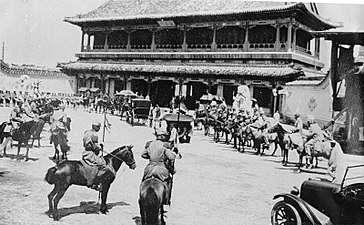 Procession of Leo Karakhan, Soviet Ambassador to China 1923–26, outside the Xinhua Gate of Zhongnanhai.
Procession of Leo Karakhan, Soviet Ambassador to China 1923–26, outside the Xinhua Gate of Zhongnanhai.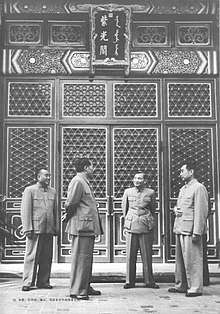 Leaders of the People's Republic, from left, Zhu De, Mao Zedong, Chen Yun and Zhou Enlai outside the Hall of Purple Light (Ziguangge) in 1954.
Leaders of the People's Republic, from left, Zhu De, Mao Zedong, Chen Yun and Zhou Enlai outside the Hall of Purple Light (Ziguangge) in 1954. Chinese President Hu Jintao with U.S. President George W. Bush and former U.S. President George H. W. Bush in Zhongnanhai on August 10, 2008.
Chinese President Hu Jintao with U.S. President George W. Bush and former U.S. President George H. W. Bush in Zhongnanhai on August 10, 2008.
Zhongnanhai today
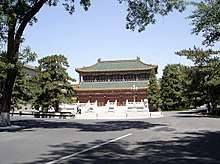
Since Zhongnanhai became the central government compound, it has been mostly inaccessible to the general public. The exception to this was during the years of relative freedom following the end of the Cultural Revolution, when the compound was open to members of the public, who could obtain tickets to visit the compound from relevant government authorities. Following the political turmoil that culminated in the Tiananmen Square protests of 1989, security was greatly increased. Access has now been closed to the general public, with numerous plain clothed military personnel patrolling the area on foot. Cars are not strictly prohibited from stopping on stretches of adjacent roadway. Cabs, for example, are allowed to stop except during important conferences or events.[11] Chinese maps of Beijing show Zhongnanhai as an insignificant green area with a water body; in contrast, the municipal government, however, is shown significantly with a red star.
The most important entrance to the compound is the southern one at Xinhuamen (Xinhua Gate, or "Gate of New China"), surrounded by two slogans: "long live the great Communist Party of China" and "long live the invincible Mao Zedong Thought." The view behind the entrance is shielded by a traditional screen wall with the slogan "Serve the People", written in the handwriting of Mao Zedong. The Xinhuamen entrance lies on the north side of West Chang'an Avenue.[1]
Zhongnanhai is considered the de jure residence of Politburo Standing Committee members and other senior leaders for electoral purposes.[12] Though it serves as their formal residence, many senior party leaders do not actually live in Zhongnnanhai, preferring to live in homes elsewhere in the city.[11] Several more recent leaders, such as then General Secretary and paramount leader Hu Jintao reportedly chose to live in the Jade Spring Hill compound in western Beijing due to overcrowding inside Zhongnanhai.[13] China's current leader Xi Jinping also has a home in Jade Spring Hill.[14] There continues to be no standardized system for awarding certain houses to leaders of a certain rank in Zhongnanhai. After a senior leader's death, their spouse is often permitted to stay in the house indefinitely.[15] Several of these houses were occupied by the families of their original post-revolution owners into the 1990s.
Internal layout
.jpg) | |
| An annotated map of Zhongnanhai. Click on the links for more information about each building. |
North Zhongnanhai
North Zhongnanhai is the headquarters of the State Council of the People's Republic of China and its affiliate institutions, including the offices of the Premier and the Vice Premiers as well as the State Council General Office. Important guests, both foreign and domestic, are typically received in North Zhongnanhai.
Regent Palace
(Chinese: 摄政王府) Located in the northwestern corner of Zhongnanhai, the area once occupied by Regent Palace is now the location of the offices of the Premier and Vice Premiers. Unlike the offices of Communist Party officials in West Building Compound, which are assigned to specific individuals and do not necessarily change if the individual changes their title or role, the offices of the Premier and Vice Premier are assigned specifically to the incumbent holders of those positions and their occupants must move out when their term ends.[16]
The building took its name from Puyi's regent Zaifeng, Prince Chun who was given the palace in 1909. The Building was not completed by the time the Qing Dynasty ended in 1911. Under the Republic of China, the building was initially the location of the Prime Minister's office and the meeting place of the Cabinet. In 1918 President Xu Shichang switched the President's residence and the Prime Minister's office, relocating his residence to Regent Palace, while the Prime Minister and Cabinet moved to Dianxu Hall in the Garden of Abundant Beneficence.[17] When Huairen Hall became the Presidential residence in 1923, Regent Palace became the location of the army and naval department.
After 1949, the People's Republic of China again used the building as the headquarters of the Premier and State Council. During the massive renovation of Zhongnanhai in the late 1970s, plans were made to modernize Regent palace. However, it was found that the quality of the building was very poor, the foundations were loose and the gaps between the wooden columns were filled with broken brick. As a result, the main hall and entrance halls were torn down and rebuilt completely.[18] The State Council's Conference Room Number Four, which is used for meeting with domestic civil society leaders, was built on the north side of Regent Palace close to West Flower Hall.[19] The main meeting place for the State Council is now next door at State Council Hall.
West Flower Hall
(Chinese: 西花厅) Located in the north west corner of Zhongnanhai, this building was constructed as the living quarters for Regent Palace. West Flower Hall served as Premier Zhou Enlai's personal residence. The building has two courtyards. The front courtyard was where Zhao would meet and dine with foreign guests, while the back courtyard included the Zhou's personal office, bedroom and meeting rooms. After Zhou's death in 1976 his wife Deng Yingchao lived here until 1990. Unlike much of the State Council area, West Flower Hall was not reconstructed in the 1970s. Today the building is preserved as a museum dedicated to Zhou Enlai.[20]
State Council Hall
(Chinese: 国务院小礼堂) Originally built as a wing of Regent Palace, State Council hall houses the main auditorium for State Council meetings. Premier Zhou Enlai resisted renovation efforts citing a commitment to fiscal austerity. The building now serves as the principal venue for not only the State Council's full plenums, but also some meetings by smaller subordinate bodies. Both the full State Council and the weekly meetings of the State Council Standing Committee meet in Conference Room Number One. Including its principle conference room, the State Council possesses a total of six meeting rooms which are used for various purposes.[19][21] The northern section of State Council Hall serves as the headquarters for the State Council General Office.[22] In the early years after 1949, the State Council Auditorium was used as a movie theatre which held showings several times a week. The building also includes a small cafeteria for State Council staff. The State Council auditoriums were reconstructed and renovated through the end of the 1970s and opened again in 1979.[23]
Ziguang Hall
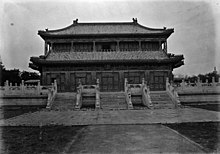
(Chinese: 紫光阁) Located in the northern west bank of the Central Sea, Ziguang Hall is a two-story pavilion. Immediately behind Ziguang Hall is another pavilion called Wucheng Hall (Chinese: 武成殿), which connects to Zignang Hall to form a courtyard. The Ming Dynasty Jiajing Emperor, built Ziguang Hall as a replacement for Yingtai Island. The building was rebuilt by Qing Dynasty Emperor Kangxi, who would use the location to inspect his bodyguards. During the reign of the Qianlong Emperor the building was used to display battle wall charts and seized weapons. The building was also known as the Hall of Barbarian Tributes and was used to receive tribute missions to the Emperor. After 1949 the building was occasionally used for dances.[24] A large modern conference area was later built on the building's western side. Ziguang Hall is used today as the main reception area in Zhongnanhai for meeting with foreign diplomats and conducting talks with world leaders.[25] Wucheng Hall is often used for photo opportunities in which a Chinese leader will be pictured sitting alongside their visiting counterpart.[26]
Tennis Court
Initial plans to build an indoor tennis court in the State Council section of Zhongnanhai were made in the late 1980s. At the time China was receiving a significant influx of new diplomatic delegations on international exchange trips. Feeling that the facilities for hosting these diplomats at Ziguang Hall at the time were inadequate, some officials proposed that a guest lounge and tennis court be built nearby. The proposal for an indoor tennis court was, at the time, vetoed by Vice Premier Tian Jiyun.[27] In spite of this initial resistance, an outdoor tennis court was built in Zhongnanhai by the early 2000s.[28] In 2006, the building around the tennis court was rebuilt and modernized.[29]
Indoor Pool
The indoor swimming pool was built in 1955 by the Urban Construction and Design Institute. Mao Zedong's wife Jiang Qing reportedly proposed the building's construction during Mao's absence in order to secure its approval. Mao nonetheless used the pool because it was more convenient than traveling to the pool at Tsinghua University. Mao often stayed and worked at the pool for long periods of time. In 1958, Mao met with Soviet General Secretary Nikita Khrushchev at the pool. During the time when Mao leaved nearby at Poolside House, the indoor swimming pool was remodeled and enlarged under the supervision of Zhongnanhai's head engineer Tian Genggui. Today the pool is used by senior party leaders and also contains a workout area.[30]
Poolside House
(Chinese: 游泳池) The Poolside House was built right next to the large indoor swimming pool, initially for practical reasons, as Mao Zedong would frequently spend much of the day either swimming in the pool or reading political and historical books and reports from government officials by the pool's side. Therefore, a reception room, a bedroom and a study with Mao's favorite books were built, thus creating the Poolside House which allowed Mao to be permanently close to the swimming pool.[31] Eventually, among Zhongnanhai staff, the phrase "you are wanted at the swimming pool" meant that they were ordered to immediately report to Mao.[31]
Mao permanently left the Chrysanthemum Library and moved into the Poolside House in 1966, at the beginning of the Cultural Revolution. Especially in his later years, the Poolside House would be the place for visiting foreign leaders to see Mao. This was the case for Richard Nixon and Kakuei Tanaka.[31] After Mao's death in 1976, Zhou Enlai's wife Deng Yingchao briefly lived here during the extensive reconstruction to Regent Palace and West Flower Hall before returning to West Flower Hall after the completion of the renovation.[32][33]
The original outdoor swimming pool adjacent to Poolside House was built in 1933 as a public-private partnership when Zhongnanhai was a public park. Tickets were sold for Beijing citizens each year from May to August. From 1946 to the end of the Republic of China, it was difficult to operate the pool profitably due to inflation.[34]
Yanqing House
(Chinese: 延庆楼) Yanqing House as well as several other adjoining buildings were built during the Beiyang Government around 1922. During his time as de facto ruler of the Beiyang Government, Cao Kun used Yanqing House as his workplace while living in nearby Huairen Hall. His wives and concubines lived in several of the adjoining buildings. After Cao Kun was overthrown in 1924, he was imprisoned in Yanqing House for two years.[35][36]
Wan Shan Temple
(Chinese: 万善殿) Known in English as Thousand Benevolence Hall, Wan Shan is a Buddhist Temple located in the east coast of the Central Sea. Originally known as Chongzhi Hall, the temple was built by the Ming Dynasty Jiajing Emperor. Statues of the Buddha line the hall. Behind the temple is Thousand Sage Hall, which includes a dome and seven story Pagoda.[1]
Water Clouds Pavilion
(Chinese: 水云榭) Located on an island in the Central Sea, the pavilion contains a stele engraved by the Qianlong Emperor reading "Autumn Wind on the Taiye Lake". Taiye Lake is an old name for the all three of the seas.[1]
South Zhongnanhai
South Zhongnanhai is the headquarters of the Communist Party of China, including the office of the General Secretary and the offices of the staff of the Central Committee General Office. South Zhongnanhai also includes the meeting places for the Politburo, Standing Committee and Secretariat.
Huairen Hall
Huairen Hall (Chinese: 怀仁堂; lit.: 'Hall of Cherished Compassion') is a two-story Chinese style hall that is used by the Communist Party as the main meeting place for the Politburo and as an alternate meeting place Politburo Standing Committee.[37][38] The building is also the meeting location of several of the Communist Party's leading groups such as the Financial and Economic Affairs Leading Group and the Leading Group for Comprehensively Deepening Reforms.[39][40]
The building served as the daily workplace of Dowager Empress Cixi, the then de facto ruler of China, replacing the Hall of Mental Cultivation in the nearby Forbidden City. After the Boxer rebellion, Huairen Hall became the headquarters of the occupying Eight Nation Alliance's commander Alfred von Waldersee until the building was damaged in a fire. In 1902 Empress Cixi rebuilt Huairen Hall at a cost of five million taels of silver before ultimately dying here in 1908.[41] After the founding of the Republic of China in 1911, President Yuan Shikai used the building to meet with foreign guests and to accept New Year's day greetings. After Yuan's death, it was the site of his funeral. When Cao Kun became president, he used Huairen Hall as his residence. After the end of the Beiyang Government Huairen Hall had no permanent use and was given to the Beijing City Government.[8]
After the founding of the People's Republic of China, the first plenary session of the Chinese People's Political Consultative Conference was held in Huairen Hall in 1949. In 1953, the building was remodeled as a two story hall in preparation for the Asia-Pacific Peace Conference by Premier Zhou Enlai.[42] The new meeting hall was then used for first session of the National People's Congress in 1954.[43] Huairen Hall became the auditorium of the central government, often hosting various art shows and political meetings, including Central Committee plenums before the construction of Jingxi Hotel in 1964.[44]
Qinzheng Hall
(Chinese: 勤政殿) Qinzheng Hall is the headquarters of the Secretariat of the Communist Party of China and the location of the office of the party's General Secretary, a title currently synonymous with the paramount leader of the country.[45] The building also includes a conference room that serves as the main meeting place for the Politburo Standing Committee.[46][47][48] In addition to the office of the General Secretary, Qinzheng Hall is also the location of the office of the First Secretary of the Secretariat, who has de facto responsibility for the secretariat's day to day administration of the party due to the General Secretary's role of running the country.[49] There is an encrypted hotline that runs from Qinzheng Hall to the White House in Washington, D.C. for the purpose of conducting high level talks with American leaders.[50]
The original Qinzheng hall was built by the Kangxi Emperor as the main hall of the Zhongnanhai complex, serving as the Emperor's primary living and working space in Zhongnanhai.[51][52] After the 1911 revolution, the building served as a venue for government conferences during both the Republic of China and the People's Republic of China. Qinzheng Hall served as the meeting place for the Central People's Government Committee, the interim council that governed China from 1949 until the promulgation of the 1954 Constitution.[53] While serving as the headquarters of the Central People's Government, Qinzheng hall was the site of the 1951 Seventeen Points Agreement which established the terms under which Tibet would come under the sovereignty of the People's Republic of China.[54] In the late 1970s, Wang Dongxing, the director of the Central Committee General Office, demolished Qinzheng hall and spent 6.9 million yuan intended for its reconstruction to build his own private residence there. Wang's removal as head of the Central Committee General Office in 1978 prevented him from completing his plan. Qinzheng hall was inaugurated as the Secretariat's headquarters in 1980.[45]
Benevolence Hall
(Chinese: 居仁堂) This no longer existant building was a two-story western style palace known as the Hall of the Calm Sea (Haiyantang) during the Qing Dynasty. Dowager Empress Cixi had the building built to entertain her female guests and also to receive foreign diplomats. After the suppression of the Boxer Rebellion, Eight Nation Alliance commander Alfred von Waldersee moved here after Yi Luang Temple was destroyed in a fire. After the founding of the Republic of China the building was renamed the Hall of Benevolence (Jerentang), by Yuan Shikai, who continued to use it to host visitors.[55][6]
After 1949, the building served as the first headquarters of the Central Military Commission (CMC) before the CMC staff relocated outside of Zhongnanhai. In 1956, the CPC Secretariat became an institution separate from the staff of the Party Chairman and required its own headquarters. The new General Secretary, Deng Xiaoping, chose Benevolence Hall to house the Secretariat. The building was finally demolished in 1964. The Secretariat offices temporarily moved to "Building C" in the West Building compound before moving to Qinzheng Hall in 1980.[56]
West Building Compound
(Chinese: 西楼大院) This complex of buildings is named for its location in the south western corner of Zhongnanhai. The buildings were built by the engineering battalion of the Central Guard Regiment in from 1949 to 1951 to house workplaces and apartments for the Central Committee General Office's staff. West Building is the main workplace of the Director of the Central Committee General Office.[57] In addition to the West Building Hall (Chinese: 西楼大厅), the other buildings in the West Building Complex were designated A, B, C, D and F. Buildings C and D were originally intended to be used as accommodations for Provincial Communist Party Committee Secretaries when they were visiting Beijing for meetings.[58] Many of the Mishus or secretarial staff assigned to support the General Office work here. As late as the 1990s, West Building Compound included a dormitory for the young workers of the Center Committee General Office.[11] The West Building includes a large kitchen and cafeteria for the General Office staff and a smaller eating area that doubles as a conference room for the use of senior leadership.[59]
Between 2007 and 2008, part of the original West Building Compound was demolished to make way for a new three story rectangular building that was completed by 2010.[60] The Central Committee General Office's physical office footprint has now expanded beyond Zhongnanhai to include several buildings on the other side of Fuyou Street from West Building as well as other buildings in the Xicheng District area.[61] The gate on Fuyou Street that Central Committee staff use to travel between buildings inside and outside of the complex is called the "Great West Gate" because it has the highest regular use of Zhongnanhai's gates.[62]
The President's office and staff were also located in the West Building Compound during the time when the office of was not also simultaneously held by the paramount leader, such as during Liu Shaoqi's term from 1959-1967. Liu Shaoqi's office was located in Building A.[63][64] Likewise, Marshal Zhu De's office was located in Building B of the West Building compound when he served as Vice President of China.[65]
In 1962, Liu Shaoqi presided over an extraordinary, enlarged meeting of the Politburo Standing Committee in this location, known as the "West Building Meeting". At the meeting, the party leaders discussed in significant detail the dire fiscal and economic situation in the country in the aftermath of the failure of the Great Leap Forward and promised to recover the agricultural sector.[66]
Garden of Abundant Beneficence
(Chinese: 丰泽园) Some of these buildings were built by Emperor Kangxi of the Qing Dynasty who originally used them to raise silkworms. More buildings were later added by Emperor Qianlong, who used them as libraries and as a personal retreat. Throughout this garden, there are wooden placards at the buildings’ entrances, inscribed by Emperor Qianlong.[67] In the northwestern area of the garden is a building called Chunlianzhai (Chinese: 春耦斋) which once housed the seal of Emperor Qianlong and several artworks. After the Boxer Rebellion Chunlianzhai was looted and it subsequently became a summer residence for the commander of the German contingent of the Eight Nation Alliance Army. In the early days of the People's Republic of China Chunlianzhai was used as a dance hall, where dances were held twice a week by senior party leaders.[68][69][70]
The largest building in the Garden of Abundant Beneficence is Dianxu Hall, which was known as Chong Ya Temple during the Qianlong Emperor's reign, Yiennian Temple (Chinese: 颐年堂) during the Guangxu Emperor's reign and finally as Yitingnian during the Republic of China. During the Beiyang Government (1912-1928) of the Republic of China, the office of the President was initially located in Dianxu Hall. In 1918 President Xu Shichang switched the President's residence and the Prime Minister's office, relocating his residence to Regent Palace, while the Prime Minister instead moved to Dianxu Hall in the Garden of Abundant Beneficence. Dianxu Hall became a general purpose meeting area for Communist Party officials after 1949.[7] During Mao Zedong's time as Paramount Leader, Politburo Meetings were often held in Dianxu Hall due its proximity to Mao's house.[71]
The Garden of Abundant Beneficence also contains Chairman Mao Zedong's first personal residence and office, which he used from 1949 to 1966, a building called the Library of Chrysanthemum Fragrance (Chinese: 菊香书屋). Mao relocated to a new building known as the Poolside House in 1966 at the start of the Cultural Revolution. After Mao's death, the Chrysanthemum Library was preserved as a museum which is not accessible to the general public.[4] Immediately to the east of the Library of Chrysanthemum Fragrance are a series of buildings known as the West Eight Houses (Chinese: 西八所), which served as a dormitory for Mao's personal aides and secretaries.[72]
Shuqingyuan Pavilion
(Chinese: 淑清院) Located in the northeast corner of the Southern Sea, the building was built for the Qianlong Emperor as part of a small garden, similar in style to the Beihai Park. After 1959, the original building was destroyed in order to make way for the construction of a barracks and officer staff quarters for Unit 8341, the Zhongnanhai security guard regiment.[73]
Building 202
(Chinese: 202别墅) The building next to Huairen Hall was constructed in 1974 as a specially reinforced earthquake shelter.[74] Mao Zedong was relocated here from Poolside House after the July 1976 Tangshan earthquake. Mao died in this building on September 9, 1976.[75][76]
West Four Houses
(Chinese: 西四所) These four houses were built as part of the western wing of the Huairen Hall complex. They are also known as Qingyuntang (Chinese: 庆云堂). These buildings were acquired by the Peking Institute of Historic Research after the end of the Beiyang government.[77] After 1949, the Propaganda Department was located here before it was eventually moved to its current headquarters on 5 West Chang'an Street.[74] Several communist party leaders also lived in these buildings including Deng Xiaoping, Li Fuchun, Chen Yi and Tan Zhenlin.[4] During his paramount leadership, Deng Xiaoping used his home as a meeting place for informal conferences that would include members of the Central Advisory Commission, the Politburo, the Secretariat and the party elders. It was in Deng's home that the decision was made to use force against the demonstrators during the 1989 Tiananmen Square Protests.[78]
Wanzi Gallery
(Chinese: 万字廊) The original buildings in this area were built by the Qianlong Emperor to celebrate his mother's 50th birthday. Though the Qing-dynasty era buildings in the area no longer exist, this narrow lane in south-western Zhongnanhai where they once stood is now lined with houses that serve as residences of party leaders. Yang Shangkun, who served as Secretary General of the Central Military Commission, President of China, and was one of the Eight Elders of the Deng Xiaoping Era lived in one of these buildings.[4][11]
Shortly after the founding of the People's Republic, Liu Shaoqi lived here before moving into the newly constructed West Building compound. He later moved to a building called Fuluju (Chinese: 福禄居) in the same area. After Liu was denounced and purged, both Wanzi Gallery and Fuluju were demolished during the Cultural Revolution.[79] Wanzi Gallery was later reconstructed and Mao's wife Jiang Qing lived in what was then called Building No. 201 during the height of the power of the Gang of Four. This building was also known as the Spring Lotus Chamber.[80][81]
Yingtai Island
(Chinese: 瀛台) Located in the Southern Sea, the artificial island was completed by in 1421 by Ming Emperor Yongle after he relocated his capital to Beijing. The island was given its current name by Qing Emperor Shunzhi in 1655. Yingtai Island is connected with the shore via a stone bridge. Due to the slope of the island, the northern elevation of the island's main temple is a single-story building while the south elevation is a two-story pavilion, called "Penglai Pavilion." There are two temples to the north of Hanyuan Temple, Qingyun Temple to the east and Jingxing Temple to the west. In July 1681 the Qing Emperor Kangxi held the "Yingtai hearings,"[82] on the development of a national strategy to put down civil strife. Dowager Empress Cixi imprisoned Emperor Guangxu at Hanyuan Temple on Yingtai in August 1898 after the failure of Hundred Days Reform. Emperor Guangxu was subsequently poisoned and died here in 1908.
After 1949 Yingtai was used as the site of banquets and other hospitality activities.[83] According to some sources Jiang Zemin lived in Hanyuan Temple on Yingtai Island during his time as paramount leader.[84]
Xinhua Gate
(Chinese: 新华门) Zhongnanhai's main entrance, Xinhua Gate is located on West Chang'an Avenue. The gate was originally built by the Qianlong Emperor as a pavilion for one of his concubines. After the 1911 Revolution , Yuan Shikai transformed the pavilion into a gate and named it "Xinhua Gate" or "New China Gate". The slogans "Long live the great Chinese Communist Party " and "long live invincible Mao Zedong Thought " are now on the walls on both sides of Xinhua Gate. On the door is the inscription "serve the people" in Mao Zedong's handwriting.[1] In 1959, an underground passage was built between Xinhua Gate and the Great Hall of the People shortly before the construction of the latter was completed. This passage was intended to be used only by members of the Politburo Standing Committee at the time.[85]
Gallery
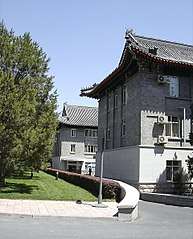 Office buildings inside Zhongnanhai
Office buildings inside Zhongnanhai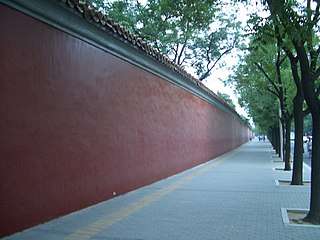 The western wall of the Zhongnanhai compound and Imperial City of Beijing
The western wall of the Zhongnanhai compound and Imperial City of Beijing Road inside Zhongnanhai
Road inside Zhongnanhai From the central part of Zhongnanhai across the Middle Sea, to the bridge that divides Zhongnanhai from Beihai Park, with the White Stupa of the Beihai Park seen in the distance
From the central part of Zhongnanhai across the Middle Sea, to the bridge that divides Zhongnanhai from Beihai Park, with the White Stupa of the Beihai Park seen in the distance
See also
- History of Beijing
- Imperial City, Beijing
- Beihai Park
- Summer Palace
- Old Summer Palace
- Jade Spring Hill
- Presidential Palace, Nanjing
References
- "Zhongnanhai - the Political Center of China". travelchinaguide.com. TravelChinaGuide. Retrieved 7 February 2018.
- Woodrow Wilson Center
- French Presidents' China complex People's Daily Online
- "毛泽东在中南海的家". 360doc.com. Beijing six-chi Information Technology Co. Retrieved 7 February 2018.
- "Zhongnanhai (Central and South Lakes)". china.org.cn. China Internet Information Center. Retrieved 27 February 2018.
- "随历史远去的中南海居仁堂". 随历史远去的中南海居仁堂. Phoenix New Media Limited. Retrieved 8 February 2018.
- "神秘的中南海建筑群". 360doc.com. Beijing six-chi Information Technology Co. Retrieved 8 February 2018.
- http://www.25dx.com/beijing/2006/200607/2006-07-09/206729.html
- "揭党中央搬进中南海往事:毛泽东为何不愿意进中南海". book.people.com.cn/. Retrieved 19 May 2020.
- "毛泽东曾拒绝入住中南海:"我不搬,我不做皇帝"". history.people.com.cn/. Retrieved 19 May 2020.
- Kristof, Nicholas (January 25, 1991). "Columnist". The New York Times. Retrieved 7 February 2018.
- "Chinese leaders vote in local elections". People's Daily. people.cn. November 9, 2006. Retrieved 1 March 2018.
- "罗冰:江泽民抓到胡锦涛甚么把柄". duping.net. The Independent Review. Retrieved 9 February 2018.
- "Beijing Police Detain Hundreds For Trying to Visit Chinese Leaders Over New Year". Broadcasting Board of Governors. Radio Free Asia. 2015-02-20. Retrieved 1 March 2018.
- Wang, Dongya. "文汪东亚". NetEase Inc. Retrieved 10 February 2018.
- "总理吃中餐也要排队 走进神秘的中南海(组图)". wenxuecity.com. 2005-09-01. Retrieved 16 February 2018.
- Zhen, Jiang. "袁世凯做洪宪梦 冯国璋发卖鱼财变幻大王旗的总统府". xueshu.com. Retrieved 11 February 2018.
- "中南海內周總理故居,原只是攝政王府西花園的". kknews.cc. DMCA. Retrieved 8 February 2018.
- "北京国务院有几个会议室?内鬼在哪个会议室?(组图)". wenxuecity.com. wenxuecity.com. 2017-07-04. Retrieved 22 February 2018.
- "西花厅". Baike.com. Baidu Baike. Retrieved 7 February 2018.
- "国务院常务会议照片,国务院常务委员会名单". mxzx123.net. Star Information Network. Retrieved 26 February 2018.
- "General Office of the State Council". google.com/maps. Retrieved 4 March 2018.
- "中南海里的建筑也曾遭"拆迁"". sohu.com. Retrieved 7 February 2018.
- "中南海舞会见闻:毛主席跳舞踩不到点". People's Daily. People's Network. 2011-03-01. Retrieved 12 February 2018.
- "中南海紫光阁史话". 360doc.com. Beijing six-chi Information Technology Co. Retrieved 8 February 2018.
- "中南海照片首次曝光,太难得一见,赶紧看!". aixincb.com. aixincb.com. Retrieved 19 May 2020.
- Zhao, Qingyun. "老干部忆80年代中南海:国务院配车是淘汰车型". news.ifeng.com. Phoenix New Media Limited. Retrieved 19 May 2020.
- Zhu, Xiaoping. "万里的体育情怀". chinaqw.com. Retrieved 19 May 2020.
- "Historical data from Google Earth". Google Earth. Retrieved 19 May 2020.
Data from April 2006
- "游泳池 卫生间…如何修缮中南海内毛泽东住所". People's Daily. People's Network. Retrieved 7 February 2018.
- Dr. Li Zhisui, The Private Life of Chairman Mao, II: 1949–1957, 5, Random House, (1994)
- "中南海内修缮工程杂忆". People's Daily. Retrieved 7 February 2018.
- "毛主席去世后,一女正国级领导住过他在中南海的房子,还做了一大事". 360doc.com. Retrieved 6 February 2018.
- "北京第一家公共游泳池". Old Beijing. Retrieved 24 May 2020.
- Ok, Tim. "导游图库(122)中南海". blog.sina.com.cn/. SINA Corporation. Retrieved 14 February 2018.
- "中南海前传(6)烧成灰烬的仪鸾殿". blog.sina.com.cn/. SINA Corporation. Retrieved 14 February 2018.
- Wang, Jun (15 June 2013). "中央政治局如何开会". qikan.com. Retrieved 18 October 2017.
- ""怀仁堂政变"后的政治局紧急会议". DWnews.com. Deutsche Welle. Retrieved 5 February 2018.
- Chen, Zhu Qin (2014-06-19). "习近平主持中央财经领导小组会议,还有谁在座?". Shanghai Oriental Press Co. The Paper. Retrieved 11 February 2018.
- "全面深化改革领导小组会议部分参会人员名单". eastday.com. 23 January 2014. Retrieved 6 March 2018.
- 陶无梦·《春冰室野乘》:佛照楼即仪銮殿旧址。殿毁于庚子之乱,回銮后重修,费帑五百余万。
- 刘宁一·《周恩来与建国前后的人民外交》:“恩来同志亲自制定了改造怀仁堂的方案,把原来仅能容纳300多人的一个四合院改建成能容900人的大礼堂。”
- "第一屆全國人民代表大會和中華人民共和國憲法的制定". People's Daily. People's Network. Retrieved 25 February 2018.
- "中共第八届历次中央全会". gov.cn. gov.cn. Retrieved 25 February 2018.
- "文革后的中南海:中央办事效率最高的时期". Comsenz Inc. Retrieved 7 February 2018..
- 瀚雅画廊. "天道酬勤绘沧桑——著名山水画家张登堂". gallery.artron.net. Retrieved 10 December 2018.
- "赵紫阳:5月17日决定六四悲剧 李鹏日志:邓小平提戒严令". backchina.com. Overseas Chinese. Retrieved 9 February 2018.
- 李南央. "鲍彤再看六四(二):我是如何被抓进秦城的". The New York Times. Retrieved 10 December 2018.
- Ta, Kung Pao. "曾庆红三次拥抱,谢幕退出政坛". boxun.com. Retrieved 21 May 2020.
- "解密红色电话:"一号机"没有拨号盘和加密按键". Phoenix New Media Limited. ifeng.com. January 13, 2014. Retrieved 9 February 2018.
- "中南海勤政殿见证特殊友谊". qd8.com.cn. qd8.com.cn. Retrieved 12 February 2018.
- "中共高官揭汪东兴丑闻:拆中南海勤政殿建豪宅 消息被封杀". aboluowang.com. aboluowang.com. Retrieved 23 February 2018.
- "1949年10月1日 中央人民政府委员会举行第一次会议". People's Daily. People's Network. Retrieved 25 February 2018.
- Akiner, Shirin. "Resistance and Reform in Tibet". Retrieved 24 May 2020 – via Google Books.
- "Zhongnanhai". GlobalSecurity.org. John Pike. Retrieved 8 February 2018.
- Wu, Han. "百年烟云居仁堂". Retrieved 8 February 2018.
- "readers365.com". 第一篇在爷爷奶奶身边长大. Retrieved 9 February 2018.
- "我在不寻常年代的特别经历_王凡【完结】(60)". 52shuku.me. Retrieved 20 May 2020.
- "中南海里的日常生活". 360doc.com. Beijing six-chi Information Technology Co. Retrieved 7 February 2018.
- "Historical data from Google Earth". Google Earth. Retrieved 19 May 2020.
Data from February 2007, May 2008 and May 2010
- "2015年中央办公厅遴选公务员面试公告". chinagwy.org. Retrieved 19 May 2020.
- 王凡:中南海西楼刘少奇一家人的平民生活. difangwenge.org. Retrieved 20 May 2020.
- "毛泽东秘书田家英文革被逐出中南海自杀真相". 360doc.com. Beijing six-chi Information Technology Co. Retrieved 13 February 2018.
- "毛泽东指责哪位高干"荒淫"". qq.com. Tencent. Retrieved 7 February 2018.
- Tian, Baojun. "建国后朱德元帅的住房:还不如苏联集体农庄主席". Phoenix New Media Limited. ifeng.com. Retrieved 17 February 2018.
- "西楼会议(1962年2月21日-23日)". People. Retrieved 19 May 2020.
- Dr. Li Zhisui, The Private Life of Chairman Mao, II: 1949–1957, 6, Random House, (1994)
- "上海工美2015年春拍呈现项圣谟《临韩滉五牛图》". news.artron.net. Yachang Art Network. Retrieved 19 May 2020.
- "《春耦斋》御玺及"春耦斋"往事". 99ys.com. Retrieved 19 May 2020.
- "震惊披露,元勋们的红墙内生活!". freewechat.com. Retrieved 19 May 2020.
- Chen, Huan. "深情的回忆 ——瞻仰中南海毛泽东故居所想起的往事". chinaqw.com. Retrieved 19 May 2020.
- Qi, Benyu. "第一章 初进中南海,任政秘室见习秘书". marxists.org. Retrieved 21 May 2020.
- "揭秘中国最神秘的禁地——中南海". Sina Corp. Retrieved 19 May 2020.
- "毛泽东与中南海:人生最后十年在游泳池度过【3】". People's Daily. People's Network. Retrieved 7 February 2018.
- Terrill, Ross (August 2010). 毛泽东传. Renmin University of China. Retrieved 7 February 2018.
- "Introduction to Zhongnanhai CP Leadership Compound Schematic Map 02". drben.net. ChinaReport.com. Retrieved 7 February 2018.
- "苏秉琦的六十年考古人生". mjlsh.usc.cuhk.edu.hk/. Chinese University of Hong Kong. Retrieved 8 February 2018.
- Zhao, Ziyang (2009). Prisoner of the State. Simon & Schuster. p. 23. ISBN 9781847377142. Retrieved 8 February 2018.
- "元勋的红墙生活:三年困难时期中南海里捞鱼吃(图)". chinanews.com. Retrieved 19 May 2020.
- Wang, Shen (2009-11-05). ""四人帮"被捕:江青很平静 王洪文反抗最激烈". Phoenix New Media Limited. Retrieved 8 February 2018.
- "The Last Week of Mao Zedong". bostonese.com. bostonese.com Online Journal. Retrieved 7 February 2018.
- SalviNg (2014-11-14). "習近平奧巴馬瀛台談話部分內容首次曝光". WENWEIPO.COM LIMITED. Retrieved 8 February 2018.
- 【揭密】习近平奥巴马在瀛台到底聊了什么(习奥瀛台夜话全记录)
- "金婚纪念日江泽民为何邀请同窗到中南海相聚?". Phoenix New Media Limited. ifeng.com. March 10, 2013. Retrieved 15 February 2018.
- "探秘中国最神秘的地方——中南海". sinovision.net. Retrieved 19 May 2020.
External links
| Wikimedia Commons has media related to Zhongnanhai. |
- TIME: Walled Heart of China's Kremlin
- Google Satellite picture
- China.org.cn - Introduction to Zhongnanhai
- (in Chinese) China.com.cn - Zhongnanhai with images of Zhongnanhai today.